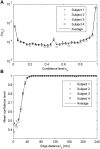Estimating the confidence level of white matter connections obtained with MRI tractography
- PMID: 19104666
- PMCID: PMC2603475
- DOI: 10.1371/journal.pone.0004006
Estimating the confidence level of white matter connections obtained with MRI tractography
Abstract
Background: Since the emergence of diffusion tensor imaging, a lot of work has been done to better understand the properties of diffusion MRI tractography. However, the validation of the reconstructed fiber connections remains problematic in many respects. For example, it is difficult to assess whether a connection is the result of the diffusion coherence contrast itself or the simple result of other uncontrolled parameters like for example: noise, brain geometry and algorithmic characteristics.
Methodology/principal findings: In this work, we propose a method to estimate the respective contributions of diffusion coherence versus other effects to a tractography result by comparing data sets with and without diffusion coherence contrast. We use this methodology to assign a confidence level to every gray matter to gray matter connection and add this new information directly in the connectivity matrix.
Conclusions/significance: Our results demonstrate that whereas we can have a strong confidence in mid- and long-range connections obtained by a tractography experiment, it is difficult to distinguish between short connections traced due to diffusion coherence contrast from those produced by chance due to the other uncontrolled factors of the tractography methodology.
Conflict of interest statement
Figures







Similar articles
-
Mapping brain anatomical connectivity using white matter tractography.NMR Biomed. 2010 Aug;23(7):821-35. doi: 10.1002/nbm.1579. NMR Biomed. 2010. PMID: 20886567 Free PMC article. Review.
-
White matter tractography by means of Turboprop diffusion tensor imaging.Ann N Y Acad Sci. 2005 Dec;1064:78-87. doi: 10.1196/annals.1340.014. Ann N Y Acad Sci. 2005. PMID: 16394149
-
Estimation of white matter connectivity based on a three-dimensional directional diffusion function in diffusion tensor MRI.Med Phys. 2006 Dec;33(12):4643-52. doi: 10.1118/1.2374855. Med Phys. 2006. PMID: 17278817
-
[Magnetic resonance tractography in neuroradiological diagnostic aspects].Otolaryngol Pol. 2009 Sep-Oct;63(5):403-6. doi: 10.1016/S0030-6657(09)70151-9. Otolaryngol Pol. 2009. PMID: 20169904 Polish.
-
Association, commissural, and projection pathways and their functional deficit reported in literature.J Comput Assist Tomogr. 2006 Sep-Oct;30(5):695-715. doi: 10.1097/01.rct.0000226397.43235.8b. J Comput Assist Tomogr. 2006. PMID: 16954916 Review.
Cited by
-
Connectivity and tissue microstructural alterations in right and left temporal lobe epilepsy revealed by diffusion spectrum imaging.Neuroimage Clin. 2014 Aug 1;5:349-58. doi: 10.1016/j.nicl.2014.07.013. eCollection 2014. Neuroimage Clin. 2014. PMID: 26236626 Free PMC article.
-
Exploring brain function from anatomical connectivity.Front Neurosci. 2011 Jun 21;5:83. doi: 10.3389/fnins.2011.00083. eCollection 2011. Front Neurosci. 2011. PMID: 21734863 Free PMC article.
-
The structural connectome in children: basic concepts, how to build it, and synopsis of challenges for the developing pediatric brain.Neuroradiology. 2017 May;59(5):445-460. doi: 10.1007/s00234-017-1831-1. Epub 2017 Apr 5. Neuroradiology. 2017. PMID: 28382501 Review.
-
Reduced fronto-temporal and limbic connectivity in the 22q11.2 deletion syndrome: vulnerability markers for developing schizophrenia?PLoS One. 2013;8(3):e58429. doi: 10.1371/journal.pone.0058429. Epub 2013 Mar 22. PLoS One. 2013. PMID: 23533586 Free PMC article.
-
Hierarchical topological network analysis of anatomical human brain connectivity and differences related to sex and kinship.Neuroimage. 2012 Feb 15;59(4):3784-804. doi: 10.1016/j.neuroimage.2011.10.096. Epub 2011 Nov 12. Neuroimage. 2012. PMID: 22108644 Free PMC article.
References
-
- LeBihan D. Looking into the functional architecture of the brain with diffusion MRI. Nat Rev Neurosci. 2003;4:469–480. - PubMed
-
- Basser P, Mattiello J, LeBihan D. Estimation of the effective self-diffusion tensor from the NMR spin echo. J Magn Res B. 1994;103:247–254. - PubMed
-
- Wedeen VJ, Reese T, Tuch DS, Weigel M, Dou J-G, et al. Mapping fiber orientation spectra in cerebral white matter with fourier-transform diffusion MRI. Proc Intl Soc Mag Reson Med. 2000;8
-
- Wedeen VJ, Hagmann P, Tseng W-Y, Reese T, Weisskoff R. Mapping complex tissue architecture with diffusion spectrum magnetic resonance imaging. Magn Res Med. 2005;54:1377–1386. - PubMed
-
- Hagmann P, Jonasson L, Maeder P, Thiran J-P, Wedeen VJ, et al. Understanding Diffusion MR Imaging Techniques: From Scalar Diffusion-weighted Imaging to Diffusion Tensor Imaging and Beyond. Radiographics. 2006;26:205–223. - PubMed
Publication types
MeSH terms
LinkOut - more resources
Full Text Sources
Other Literature Sources

